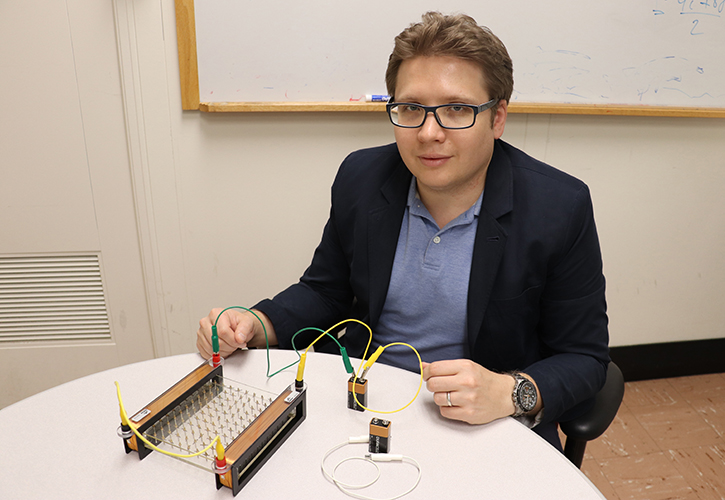College of Arts and Sciences Newsroom

UD physicist develops model that predicts Arctic ice melt
By Dave Larsen
A new study co-published by a University of Dayton physicist offers a model to better predict the effects of climate change on Arctic sea ice. Their discovery, which is gaining attention from popular science and technology publications such as Scientific American, Physics World and WIRED, could improve climate models for predicting ice loss in the Arctic.
Assistant professor of physics Ivan Sudakow published the paper, Ising model for melt ponds on Arctic sea ice, in the New Journal of Physics in collaboration with research partners at the University of Utah and Northumbria University in England.
The interdisciplinary study found a relationship between the patterns formed by pools of water from melting sea ice and the arrangement of atoms in magnetic materials. Using the Ising statistical physics model, which simulates the basic physics of ferromagnetic materials, the researchers were able to accurately replicate the melting of Arctic sea ice, using just one real-world measurement.
“It is the next important application of the Ising model itself and shows the universality of physics laws,” said Sudakow, who joined the University faculty in 2015 and specializes in mathematical modeling of physical and living systems. “It doesn’t matter where you apply this model — superconductors or melt ponds.”
Invented in 1920, the Ising model shows how natural systems can behave in related ways, such as showing phase transitions between solid, liquid and gaseous states of matter. It also has applications in the fields of neuroscience and socio-economics.
The two-dimensional Ising model consists of individual atoms arranged in a square-lattice grid, with the direction of their magnetic spins either aligned or anti-aligned with the direction of a uniform applied magnetic field. Each atom is then in either a “spin up” or “spin down” state, and is assumed to interact only with its four nearest neighbors — potentially changing the spin of adjacent atoms. This creates patches of atoms within the grid with all of their spins in the same direction.
Kenneth M. Golden, University of Utah distinguished professor of mathematics and a co-author of the study, first noticed the geometric similarities between these patches of magnetized atoms and the distribution of melt ponds across the surface of sea ice about 15 years ago.
While snow and ice reflect most of the sunlight on Arctic sea ice, melt ponds absorb and transmit that solar energy — impacting the areas of ice that surround them, much like the interaction between magnetized atoms in the Ising model.
“When the melting begins there is a horizontal heat transfer from one area of sea ice to the next, influencing expansion,” Sudakow explained. “When you are melting, you need to release your heat, so you transfer it to your partner.”
Solar reflectance and transmittance of the sea ice cover are key parameters in climate modeling, so the Ising model for Arctic melt ponds could help climate scientists better predict the loss of sea ice.
Golden credits the National Science Foundation-funded Math Climate Research Network (MCRN), with 12 hubs across the U.S., for connecting him with the two young mathematical physicists who would help him adapt the model: Sudakow, who from 2012 to 2015 served as Golden’s postdoctoral research assistant at the University of Utah, and Yiping Ma, an MCRN postdoc at the University of Chicago.
“Ivan is fearless, extremely hard working, and at the time he was one of the only young mathematicians I had ever met who was already devoting himself to the mathematics of climate and the polar regions in particular,” Golden said. “While the published form of the model has a unique simplicity that offers an alternative to large-scale, coarse-grained numerical models of sea ice, it was only through the hard work and key insights of Ivan and Yiping over a number of years that brought us to this point.”
Ma, now a research fellow in extreme environments at Northumbria University, is a co-author on the study, along with Courtenay Strong, associate professor of atmospheric sciences at the University of Utah. During summer 2018, Sudakow conducted research with Ma at Northumbria, using start-up research funds for new tenure-track faculty from the University of Dayton Department of Physics.
Sudakow teaches students about the Ising model and its applications as part of his thermal physics course. He also is investigating how to extend this model for application to other natural patterns, such as tundra lake growth and permafrost melt in the Arctic.
Sudakow wasn’t surprised by the media attention for the study, which also included Earth & Space Science News and a Wikipedia citation for applications of the Ising model.
“We know this kind of work is really interesting and something noble,” he said.
Sudakow holds a doctoral degree in applied mathematics from Novgorod State University and a master’s in physics from Ural State University, both in his native Russia.
To read the study, please visit the New Journal of Physics website.
For more information about the Department of Physics, please visit the department’s website.

Left: Arctic melt ponds (scale: kilometers) (Credit: Perovich). Middle: Simulated melt ponds from the Ising model (Credit: Ma). Right: a silver thin film (scale: microns) (Credit: Davis, McKenzie, and McPhedran)
This picture compares the real melt ponds, our modeled melt ponds, and the patterns with similar geometry but at the microscale level. We can show that patterns have similar geometry at different scales, it does not matter what is your material, the surface of sea ice or surface of thin films.
